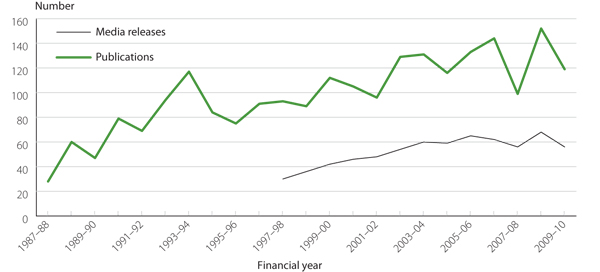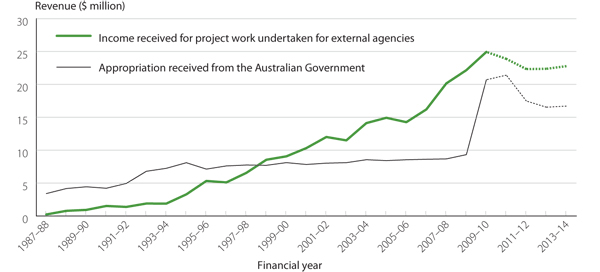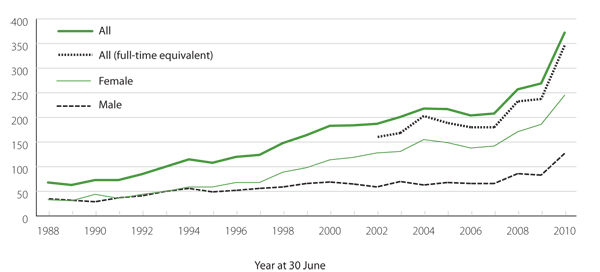In brief
Who we are
The Australian Institute of Health and Welfare (AIHW) was established as a Commonwealth statutory authority in 1987.
The Institute’s governing legislation is the Australian Institute of Health and Welfare Act 1987 (AIHW Act). The AIHW Act and its Regulations are reproduced in Appendix 1 on page 116 of the AIHW Annual report 2009–10.
The AIHW produces many public reports and actively promotes its work in the community.
The main functions of the AIHW are to collect, analyse and disseminate health-related and welfare-related information and statistics. These functions are specified in s. 5 of the AIHW Act and require information to be developed, collected and reported in the following areas:
- health
- aged care services
- child care services (including services designed to encourage or support participation by parents in educational courses, training and the labour force)
- services for people with disabilities
- housing assistance (including programs designed to provide access to crisis accommodation in the short term)
- child welfare services (including, in particular, child protection and substitute care services)
- other community services.
In these subject areas, the AIHW provides authoritative, timely information and analysis to governments and the community, drawn from the national data collections managed by the Institute. Additionally, the AIHW provides leadership and infrastructure for the development, maintenance and promotion of information standards to ensure that data are nationally consistent and appropriate for their purpose.
How we are governed
The AIHW Act establishes the AIHW Board as the Institute’s governing body. The role and composition of the AIHW Board is specified in s. 8(1).
The AIHW Board is accountable to the Parliament of Australia through the Minister for Health and Ageing and sets the overall policy and strategic direction of the Institute.
The AIHW’s Charter of Corporate Governance adopted by the AIHW Board provides the basis for the Board’s operations (see Appendix 2 on page 137 of the AIHW Annual report 2009–10).
The Director of the AIHW manages the day-to-day affairs of the Institute.
Our Minister

The Hon. Nicola Roxon MP
Minister for Health and Ageing
Accounting for outcomes
An accountability framework for the Institute (Figure 4 on page 3 of the AIHW Annual report 2009–10) shows the legislative and reporting relationships that ensure that the AIHW’s operations and funding contribute to its functions and outcomes.
The Portfolio Budget Statements for the Health and Ageing portfolio include one of the reporting components of the accountability framework for the AIHW (see Chapter 2 Our performance on page 15 of the AIHW Annual report 2009–10). The AIHW’s outcome—intended results, benefits or consequences on the Australian community—as stated in the Portfolio Budget Statements 2009–10 is:
A robust evidence base for the health, housing and community sectors, including through developing and disseminating comparable health and welfare information and statistics.
The AIHW has one program:
Develop, collect, analyse and report high-quality national health and welfare information and statistics for governments and the community.
The AIHW prepares a set of annual financial statements as required by the Finance Minister’s Orders that are made under the Commonwealth Authorities and Companies Act 1997—under which the Institute operates—and the Australian Accounting Standards. These financial statements are audited by the Australian National Audit Office. The detailed financial statements and the auditor’s report are contained in Appendix 9 on page 176 of the AIHW Annual report 2009–10.
Other components of the Accountability Framework include the AIHW Corporate Plan: strategic directions 2007–2010 and the AIHW’s annual work plans.
Our key relationships
The health and welfare information collected, analysed and disseminated by the AIHW is managed in accordance with legal and ethical obligations for privacy, confidentiality and objectivity. At the same time, this information must meet the current and emerging needs of governments and the community. Work undertaken by the AIHW commonly crosses federal, state, territory and private sector areas of responsibility. Therefore, effective engagement and relationships based on mutual trust are vital. These relationships are critical to developing nationally consistent and comparable information across jurisdictions.
Within this context, the AIHW has developed a strongly collaborative approach to its work, developing relationship networks in the Australian Government, state and territory governments, and educational and broader private sectors. This collaborative and consultative approach is reflected in the AIHW’s memoranda of understanding and national information agreements, and in the AIHW’s performance of roles such as chair, secretariat and participant in numerous national committees.
The AIHW’s key relationships at the Australian Government level include the Department of Health and Ageing, of which the AIHW is a portfolio agency; the Department of Families, Housing, Community Services and Indigenous Affairs; the Department of Education, Employment and Workplace Relations; the Department of Veterans’ Affairs; and the Australian Bureau of Statistics.
Additionally, the AIHW funds work plans supported by data-sharing agreements with a number of Australian universities, in order to facilitate collaboration and to draw on their expertise in specialist areas of data and information.
Further information on the AIHW’s governance arrangements and relationships with other bodies can be found in Chapter 1 Governance and management on page 1 of the AIHW Annual report 2009–10.
Our achievements and outputs
During 2009–10, the AIHW saw the culmination of work:
- to produce Australia’s welfare 2009 and Australia’s health 2010, both being key reference works provided for the Australian Parliament and community, and both being released with an associated conference
- to help jurisdictions in their commitment to provide meaningful performance indicator data under several Council of Australian Governments (COAG) national agreements—for health, housing, disability and Indigenous reform—including data supply, the development of new and improved performance indicators and the delivery of data quality statements
- to develop and release online the Closing the Gap Clearinghouse—in collaboration with the Australian Institute of Family Studies—aimed at improving access by policy makers, service providers and the general public to evidence on best practice and success factors in closing the gap in Indigenous disadvantage
- to help set a new direction for the collection of homelessness data that will provide more information than under previous arrangements.
Much of the new work undertaken in 2009–10 was developmental in nature or—as with the work on the COAG performance indicators—was published by other agencies. A developmental project undertaken in collaboration with the Department of Health and Ageing is still to be released. This project will provide the community with online information on the performance of individual hospitals.
The AIHW continued to provide authoritative information—as reports and bulletins or, more recently and increasingly, as interactive data available online—in areas such as health, aged care services, child care services, disability services, housing assistance and child welfare services, in collaboration with all jurisdictions and service providers.
Further information about the AIHW’s achievements and outputs can be found in the Director’s report on page ix, Chapter 2 Our performance on page 15 and—on a work group basis—in Chapter 5 Work group reports on page 53 of the AIHW Annual report 2009–10. The ‘snapshots’ listed in the ‘snapshot’ index on page 224 also give some more specific information about a number of the AIHW’s products and achievements.
Our communications
The AIHW communicates its information and data to the public and its stakeholders and clients in a variety of ways, including hard copy reports, website publications and guidelines, and other online information and data.
In 2009–10 the AIHW released 119 publications with 56 media releases (Figure 1). This was fewer than the 152 publications and 68 media releases for 2008–09. For publications, there is a pattern of ‘ups and downs’ within the overall rising annual trend. This pattern has been generally matched for media releases.
All publications are available in full text free of charge on the website. From July 2009 onwards the AIHW made all its website publications available in an additional format (RTF) that is more suitable for many people with impaired vision.
The AIHW is required by s. 31 of the AIHW Act to publish reports on Australia’s health and Australia’s welfare, both of which are key national information resources. Australia’s welfare 2009 was published in November 2009 and Australia’s health 2010 in June 2010. Both were subsequently tabled in the Australian Parliament.
Further information about AIHW’s publications and online information and data can be found in Chapter 3 Our communications on page 31 of the AIHW Annual report 2009–10.
Figure 1: Publications released, 1987–88 to 2009–10, and media releases, 1997–98 to 2009–10

Our financial performance
The AIHW’s financial results for 2008–09 and 2009–10 are summarised in Table 1 and compared with the estimates for 2009–10 that were included in the 2010–11 Portfolio Budget Statements. Revenue in 2009–10 was $46.4 million, an increase of 43.6% on 2008–09. Expenses in 2009–10 were 37.4% greater than in 2008–09. In 2009–10 the AIHW achieved a surplus of $2,177,000, which equated to 4.7% of total revenue. This compares with a surplus of $139,000 in 2008–09.
| Actual 2008–09 | PBS estimates 2009–10 | Actual 2009–10 | |
|---|---|---|---|
| Revenue | 32,347 | 43,548 | 46,445 |
| Expenses | 32,208 | 40,748 | 44,268 |
| Surplus | 139 | 2,800 | 2,177 |
The AIHW’s revenue comprises income received as appropriation from the Commonwealth Parliament and income received from external sources. The latter is mainly received for specific project work undertaken for other government departments and ministerial councils. The balance between these two income types, including budgeted revenue for the next 4 years, is shown in Figure 2.
The proportion of the AIHW’s revenue from appropriation decreased from almost 100% in 1987–88 to 29% in 2008–09. For 2009–10, the proportion increased to 45% because in the May 2009 Federal Budget the AIHW received a significant increase in its appropriation for the following 4 years. Most of this revenue is for the AIHW’s role in implementing the COAG’s federal financial framework.
Further information about AIHW’s financial performance can be found in ‘Financial performance’ on page 28 of the AIHW Annual report 2009–10.
Figure 2: Major revenue sources, 1987–88 to 2009–10, with projections, 2010–11 to 2013–14

Our people
At the end of the reporting period, there were 372 staff employed at the AIHW, equating to a full-time equivalent of 345.8 staff. Figure 3 shows changes in staff numbers since 1988. There has been a 37.8% increase (45.1% on a full-time equivalent basis) since 30 June 2009. This is associated with additional funding and subsequent project work arising from the 2009–10 Budget.
Further information about the AIHW’s staff, human resource services, facilities services, and occupational health and safety can be found in Chapter 4 Our people on page 41 of the AIHW Annual report 2009–10.
Figure 3: Staff numbers, 1988–2010




